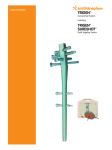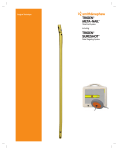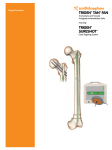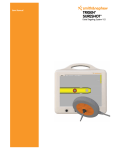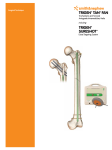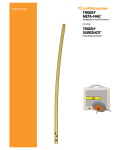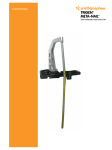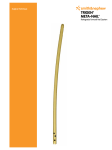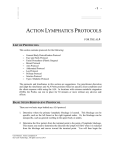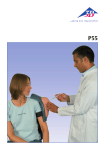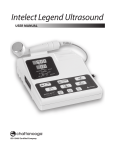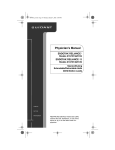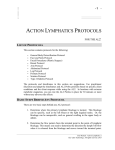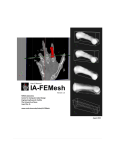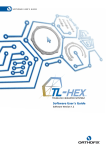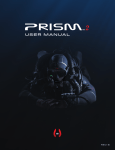Download Including - Smith & Nephew
Transcript
Surgical Technique Including 1 Surgical Technique for the TRIGEN™ Humeral Nail System using the TRIGEN SURESHOT™ Distal Targeting System Table of contents Introduction....................................................................................... 3 TRIGEN Humeral Nail indications........................................................ 4 TRIGEN SURESHOT indications........................................................... 5 TRIGEN Humeral Nail design rationale............................................... 6 TRIGEN Humeral Nail specifications................................................... 7 Warnings and cautions for TRIGEN SURESHOT ................................ 8 Surgical Technique Devices for system set up.................................................................. 10 OR preparation.................................................................................... 11 Patient positioning.............................................................................. 13 Instruments for opening the humerus................................................ 14 Incision................................................................................................ 15 Entry Tool and Guide Pin placement.................................................. 16 Instruments fracture reduction and reaming...................................... 17 Prepare proximal section.................................................................... 18 Fracture reduction............................................................................... 19 Measuring implant length................................................................... 20 Additional limited reaming.................................................................. 20 Instruments for nail assembly and insertion...................................... 21 Nail Drill Guide assembly................................................................... 22 TRIGEN SURESHOT system set up..................................................... 23 TRIGEN SURESHOT field accuracy check: optional............................ 24 Nail insertion....................................................................................... 26 Final version adjustment..................................................................... 27 TRIGEN SURESHOT system set up (continued).................................. 28 Devices to lock distally........................................................................ 30 Skin incision with TRIGEN SURESHOT................................................ 31 Targeting the locking hole.................................................................. 32 Drilling the distal hole......................................................................... 33 Screw insertion................................................................................... 34 Instruments for proximal locking, distal locking and freehand distal locking of Proximal 16cm Humeral Nails................................... 35 Distal locking screws for TRIGEN Proximal 16cm Humeral Nails....... 36 Proximal locking screws..................................................................... 37 Distal locking screws without the use of TRIGEN SURESHOT............ 40 Closure................................................................................................ 41 Removal of the nail............................................................................. 41 TRIGEN SURESHOT Trauma Interface.............................................. 42 TRIGEN SURESHOT Troubleshooting............................................... 46 Catalog information.......................................................................... 48 Nota Bene The technique description herein is made available to the healthcare professional to illustrate the authors’ suggested treatment for the uncomplicated procedure. In the final analysis, the preferred treatment is that which addresses the needs of the patient. 2 Introduction Uncover an easier and more advanced nailing system The TRIGEN™ Humeral Nail provides new possibilities for the treatment of proximal humeral fractures and humeral shaft fractures. With multiplanar screws that are threaded into the nail to inhibit proximal screw back-out, and effective, simple instrumentation that helps protect soft tissues, the TRIGEN system now offers an effective intramedullary nail for humeral fracture management. 3 Introduction TRIGEN™ Humeral Nail indications Two-part fractures of the humerus Three-part fractures of the humerus Midshaft Diaphyseal Fracture(s) Segmental Humerus Fracture(s) 4 Introduction TRIGEN™ SURESHOT™ indications Legend Important warnings appear in orange Tips, tricks and important information appear in blue Indications, contraindications, intended use and training The Smith & Nephew TRIGEN SURESHOT Distal Targeting System is intended to be an intraoperative image-guided localization system. It is a computer-assisted orthopaedic surgery tool to aid the surgeon with drill positioning for screws during intramedullary nail implantation. It provides information to the surgeon that is used to place surgical instruments during surgery utilizing intraoperatively obtained electromagnetic tracking data. The Smith & Nephew TRIGEN SURESHOT Targeting System V2.1 is indicated for long bone fractures treated with intramedullary nails in which the use of stereotactic surgery may be appropriate. An example of a surgical procedure includes but is not limited to locating and drilling the distal holes in an intramedullary nail. Contraindications The screw targeting software application for this system is contraindicated for all IM nails other than Smith & Nephew TRIGEN META-NAIL™, TAN™, FAN, Humeral, Pediatric and Adolescent nails. Do not operate the TRIGEN SURESHOT Targeter within 200mm of an installed pacemaker. The magnetic field produced by the Targeter may interfere with the operation of the pacemaker. Intended use The TRIGEN SURESHOT Distal Targeting System is only designed for use with the indicated implants and instruments. Implants and instruments must be used in accordance with the instructions, as described in this manual and/or in the non-navigated surgical procedure. Training Only trained operators are allowed to use the TRIGEN SURESHOT Distal Targeting System. The various operating instructions must be fully read and understood as part of the training. If any part of the instructions is unclear, please contact your local representative. Plausibility check As with all technical equipment, malfunctions may occur due to improper use or, more rarely, technical failure. To reduce the risks involved with such technical malfunction the operation can be completed using manually controlled instruments, providing the malfunction is detected without delay. It is, therefore, important to check the plausibility of the steps, as indicated by the system, and to carry out verification of the software targeting, particularly when using the system for the first time. Should there be any doubt regarding correct functioning, the targeting should be verified or a switch made to a traditional X-Ray technique. 5 Introduction TRIGEN™ Humeral Nail design rationale The TRIGEN Humeral Nailing System product offering includes a 16cm Proximal Straight Nail, a 16cm Proximal Bent Nail, and a full line of Long Bent Nails. Nails with a proximal bend are best suited for simple two-part fractures of the proximal humerus involving the surgical neck of the humerus and proximal third humeral fractures without comminution. In these scenarios, the proximal bend facilitates an easier entry portal attainment and nail insertion with an incision just medial to the rotator cuff insertion. The Long Bent Humeral Nail is primarily indicated for humeral shaft fractures which are inherently not prone to varus malposition. The lateral portal design allows insertion just medial to the rotator cuff insertion and facilitates easier portal attainment and nail insertion. TRIGEN 8/7mm X 16cm Proximal Straight Humeral Nail offers an alternate choice in treating different fracture patterns. Four multiplanar proximal locks improve fracture stability. 4 degree proximal bend Straight Humeral Nail The 16cm Proximal Straight Humeral Nail offers the option of a medialized entry site. If the greater tuberosity is fractured or compromised, a straight centralized starting point avoids fracture extension from the tuberosity fracture into the entry portal and resultant loss of nail stability. The entry portal for the straight nail is slightly more difficult to attain than the curved nail entry portal. Long Bent Humeral Nail Locking holes 5.0mm Cancellous Proximal Locking Screws; 24mm – 64mm lengths, 2mm increments 4.0mm Cortical Distal Locking Screws; 20mm – 40mm lengths, 2mm increments Proximal locking holes have innovative threaded design. Screws thread into the nail to help prevent screw back-out. 25° 6 25° Introduction TRIGEN™ Humeral Nail specifications TRIGEN TRIGEN TRIGEN Humeral Nail 8/7mm x 16cm Proximal Bent Humeral Nail Humeral Nail 8/7mm x 16cm Proximal Straight Humeral Nail Long Bent Humeral Nail 8/7mm, 9/7.5mm, 10/8.5mm Diameter; 18cm – 28cm lengths, by 2cm increments 35mm Trapezoidal 12mm x 10.5mm cross section Trapezoidal 12mm x 10.5mm cross section 80mm 30mm Proximal taper Proximal Taper 20mm First diameter measurement: 8mm First diameter measurement: 8mm,9mm, or 10mm Proximal Taper Second diameter Measurement: 7mm 20mm 10mm Second diameter measurement: 7mm, 7.5mm, or 8.5mm 7 Warnings and cautions for TRIGEN™ SURESHOT™ Accessibility of documentation Please ensure that all instructions are kept in an easily accessible place for operating personnel. The operator checks and decides All the information provided by the TRIGEN SURESHOT Distal Targeting System is to help the operator make decisions during the operation. The operator must check all the suggestions made by the system and is responsible for all decisions taken. Responsibility of Smith & Nephew Orthopaedics In the event of improper use, Smith & Nephew accepts no responsibility or liability whatsoever for the functioning or utility of the TRIGEN SURESHOT Distal Targeting System when used in the operating theatre. Cleaning and sterilization All instruments must be sterilized before use. Detailed information on the cleaning and sterilization of components is contained in the separate Cleaning and Sterilization Instructions (Smith & Nephew document 7138-1339). Repair or modifications to the system The user is not permitted to modify or service the equipment. There are no serviceable parts inside the unit. Refer all service to authorized personnel. Modifications/additions to the software The user is not permitted to install or uninstall software. Any new software must be installed by the manufacturer or by authorized personnel. It is only allowed to connect equipment to the interface and power supply connections of the TRIGEN SURESHOT Distal Targeting System which are IEC60601-1 approved and which are approved by Smith & Nephew Orthopaedics. Do not modify this equipment without authorization of the manufacturer. Electrical safety warning To avoid risk of electric shock, this equipment must only be connected to a supply mains with protective earth (=ground). Avoid spilling water or other liquids on electronic/electrical equipment. Use only Smith & Nephew disposables and accessories with the Smith & Nephew TRIGEN SURESHOT Distal Targeting System. Maintenance To verify accurate functionality, the device should be checked per the Maintenance Instructions contained in a separate Smith & Nephew document 7118-1927. This accuracy check must be performed at least once every 12 months. If this accuracy check is not performed as defined in the previous paragraph, all warranty claims expire and the device is operated at the user’s own risk. Recycling Old electrical and electronic equipment must be disposed separately and may not be included in the regular domestic waste. Alternatively, the unit can be handed over to Smith & Nephew Orthopaedics for correct recycling. 8 Warnings and cautions for TRIGEN™ SURESHOT™ Note Do not unplug the power while the system is running! Note Danger of damage and tipping over! Tip Place the unit on a firm, level surface capable of holding at least 10kg (22 lbs). Note To avoid the risk of electric shock, this equipment must only be connected to a supply mains with protective earth. 9 Devices for TRIGEN™ SURESHOT™ system set up TRIGEN SURESHOT Targeter Cat. No. 7169-2801 Trauma Interface Cat. No. 7169-2802 Power Cord Cat. No. 6680-0193 Note The Targeter will be operated within the sterile field and may have contact with the skin of the patient. The drill sleeve inserts will be used in the incision and have direct bone contact. Note Verify that the Targeter housing is not damaged (holes, tears, cracks). If the housing or the connector is damaged, the Targeter is no longer safe to use. Note If the Targeter is not recognized after connection to the system, the Targeter is defective and must be exchanged. (See also instrument connection). Note Broken or damaged instruments must be exchanged immediately and sent back to Smith & Nephew, Inc. Note This device is provided non-sterile and must be cleaned and sterilized per Cleaning and Sterilization (Smith & Nephew document 7138-1339) prior to use. 10 Surgical Technique – OR preparation TRIGEN™ SURESHOT™ system set up Note This procedure will cover only the specific steps of freehand targeting of intramedullary locking holes using the TRIGEN SURESHOT Distal Targeting System. For the full surgical procedure, please refer to the specific surgical technique for the TRIGEN IM Nail System being implanted. Trauma Interface setup After the sterile areas have been established, place the Trauma Interface (7169-2802) in the desired non-sterile location and turn on the power switch. Tip If the Trauma Interface does not power on, make sure the switch is in the “on” position. Note No other electrical devices should be placed near the Trauma Interface. See the “Guidance and Manufacturer’s Declaration – Separation Distances” table contained in Smith & Nephew document 7118-1927. Pressing the power button will bring up the start-up screen. When start-up screen disappears before the display prompts for tool connections, a warning screen will appear: Do not operate the TRIGEN SURESHOT Targeter within 200mm of an installed pacemaker. Note The magnetic field produced by the Targeter may interfere with the operation of the pacemaker. 11 Surgical Technique – OR preparation TRIGEN™ SURESHOT™ System set up TRIGEN SURESHOT Targeter connection When the display prompts for tool connections, connect the TRIGEN SURESHOT Targeter (7169-2801) to the Targeter port on the Trauma Interface (7169-2802). Note The Targeter body may have contact with the patient and must remain in the sterile field at all times. Only the cable and connector may be removed from the sterile field. Note This step needs to be performed at least ten minutes prior to targeting in order to ensure proper accuracy. Tip When oriented as shown, the connector should assemble easily. Do not force the connector into the port. Note If the Targeter is properly connected to the system and the application remains in this screen for more than 30 seconds, the Targeter may have been damaged during cleaning/ sterilization. In this case another Targeter has to Targeter and probe have not been connected be used. Tip It is possible at any time to disconnect and reconnect tools when the application is running. The display will show a screen reporting the missing instrument. Confirmation that the Targeter tool has been connected when the center of the Targeter lights up orange. 12 Surgical Technique Patient positioning Supine position Position the patient supine with three liter bags of saline between scapulas. Tilt the patient on the fluoroimage table so that the humerus may be extended posteriorly. The C-arm may be positioned either superior to the shoulder or opposite the shoulder if the C-arm modus is large enough. Alternative position Position the patient in a slight “beach-chair” position. The arm of the semi-recumbent patient is left to hang near the trunk thus its weight helps reposition the humeral head anterior to the acromion. The C-arm is placed above the head of the table at 30° extending distally over the shoulder. This will allow an anteroposterior view of the humerus. The arm should be placed in reverse pushing position to clear the entry point, anatomically located at the superior margin of the articular surface just medial to the greater tuberosity. Once the correct positioning and imaging are assured, the shoulder and arm are prepped and draped. 13 Surgical Technique Instruments for opening the humerus Entry Cuff Guard Cat. No. 7175-1100 Disposable Cuff Guard (Optional – may be used in place of 7175-1100 Entry Cuff Guard) Cat. No. 7175-1101 3.2mm Tip Threaded Guide Pin Cat. No. 7175-1147 Trocar Cat. No. 7175-1136 Mini Connector with Handle Cat. No. 7175-1137 Straight Entry Reamer Cat. No. 7175-1103 Cannulated Awl Cat. No. 7175-1102 Straight Ratcheting Driver Cat. No. 7175-1141 14 Surgical Technique Incision The incision approach that is recommended and most often used for antegrade humeral nailing is the lateral deltoid splitting incision. For complete fractures or nonunions, a traditional deltopectoral approach may be used. A 2-3cm incision is made from the edge of the acromion to the edge of the head of humerus, anterolateral to the tip of the acromion. The deltoid is divided down to the sub-deltoid bursa. The deltoid muscle is then retracted. Visualize the rotator cuff insertion into the greater tuberosity. The biceps tendon is palpated anteriorly. The rotator cuff supraspinatus tendon is incised 15-20mm in line with its fibers, exposing the humeral head. Insert suture into the rotator cuff interval to retract the rotator cuff and facilitate its repair after insertion of the nail. Lateral portal Entry portal is made just medial to the tendon insertion and centered midway between the biceps groove anteriorly and the posterior humeral head. Central portal (straight proximal nail) Entry portal is made at the apex of the humeral head and centered midway between the biceps groove anteriorly and the posterior humeral head. Central Portal Lateral Portal 15 Surgical Technique Entry Tool and Guide Pin placement The rotator cuff is divided to expose the superior portion of the humeral head. The Entry Cuff Guard (7175-1100) protective device should be used to retract the soft tissue of the rotator cuff for visualization of the bone. The Cuff Guard provides a visual working channel, while protecting the rotator cuff and soft tissue during the procedure. Attach the 3.2mm Tip Threaded Guide Pin (71751147) or Trocar (7175-1136) to the Mini Connector with Handle (7175-1133). Place through the Cuff Guard into the superior margin of the humeral head just medial to the greater tuberosity, avoiding the rotator cuff insertion. Verify position on the C-arm to confirm guide pin placement is aligned in the medullary canal by oblique pictures at 45° with internal and external rotation of the shoulder. Note The Disposable Cuff Guard (7175-1101) may be used to protect the rotator cuff while preparing the humerus for the nail. The Nail can be inserted through the Disposable Cuff Guard. A Drill Guide comes packaged with the Disposable Cuff Guard to facilitate the placement of the guide pin in the precise position. 16 Surgical Technique Instruments fracture reduction and reaming Straight Reducer Cat. No. 7175-1105 Straight Ratcheting Driver Cat. No. 7175-1141 2.0mm Graduated Ball Tip Guide Rod Cat. No. 7175-1146 Obturator Cat. No. 7175-1145 Ruler Cat. No. 7175-1126 Fixed Endcutting Reamers (image not shown) Cat. No. 7111-8220 to 7111-8230 Straight entry reamer Cat. No. 7175-1103 Cannulated Awl Cat. No. 7175-1102 17 Surgical Technique Prepare proximal section Insert the Straight Entry Reamer (7175-1103) over the 3.2mm Tip Threaded Guide Pin (7175-1147) or the Trocar (7175-1136) through the Entry Cuff Guard (7175-1100) and/or the Disposable Cuff Guard (7175-1101) to prepare the humerus for the proximal section of the nail. Ream until the cutting teeth are just below the articular surface of the humeral head. The depth indicator on the reamer should be level with the top of the Cuff Guard. Alternatively, the Cannulated Awl (7175-1102) can be used with the Straight Ratcheting Driver (7175-1141). 18 Surgical Technique Fracture reduction After removing the Straight Entry Reamer (7175-1103) and 3.2mm Tip Threaded Guide Pin (7175-1147) or Trocar (7175-1136), insert the Straight Reducer (7175-1105) attached to the Straight Ratcheting Driver (7175-1141) with the slot oriented toward the lateral cortex and reduce the fracture. Place the tip of the finger off the medial cortex to help reduce the fracture. To maintain reduction, introduce the 2.0mm Graduated Ball Tip Guide Rod (7175-1146) through the Straight Reducer. Center the Guide Rod 1-2cm proximal to the olecranon fossa in the distal end of the humerus. Once the Guide Rod is in place, carefully remove the Straight Reducer, using the Obturator (7175-1145) as needed to ensure the Guide Rod stays in place. 19 Surgical Technique Measuring implant length To measure the length of the implant needed, ensure that the distal tip of the 2.0mm Graduated Ball Tip Guide Rod (7175-1146) is located at the desired position of the distal tip of the nail. Slide the Ruler (7175-1126) over the proximal end of the 2.0mm Graduated Ball Tip Guide Rod and advance the open end of the Ruler to where the proximal portion of the implant will be seated, just below the articular surface of the proximal humerus. Read the nail length from the calibrations exposed at the other end of the Ruler. The 2.0mm Graduated Ball Tip Guide Rod has graduated markings and can be used to determine required implant length. The Straight Reducer (7175-1105) can also be used to determine implant length, by using the markings on the reducer shaft. Both options are used to directly measure to the articular surface, taking care to ensure the nail will be slightly countersunk. Additional limited reaming (Necessary for Proximal Nails longer than 8mm X 16cm) After the nail length has been determined, additional limited reaming can be performed to avoid nail incarceration and distraction at the fracture site during insertion of the nail. Begin with the 6.0mm Fixed Endcutting Reamer (7111-8220 to 7111-8230) and insert it over the 2.0mm Graduated Ball Tip Guide Rod. Ream the intramedullary canal sequentially. Be careful not to “push” the guide rod distally during reaming. Never insert a nail that has a larger diameter than the last reamer used. It is recommended that templating is done for all cases to estimate the size of the implant needed. The diameter of the last reamer used will help determine the diameter of the implant needed. Keep in mind that all of the nail sizes taper, and the canal should be reamed to 1mm over the implant diameter. 20 Surgical Technique Instruments for nail assembly and insertion Humeral Nail Guide Bolt Cat. No. 7175-1108 Nail Drill Guide Cat. No. 7175-1129 Guide Bolt Wrench Cat. No. 7175-1134 Impactor Cat. No. 7175-1133 Proximal Drop Cat. No. 7175-1131 Gold Outer Sleeve Cat. No. 7175-1128 3.2mm Silver Inner Drill Sleeve Cat. No. 7175-1116 3.2mm Long Graduated Two-Flute Drill Cat. No. 7175-1149 Anterior Stylus Cat. No. 7175-1130 Trocar Cat. No. 7175-1136 Humeral Nail Drill Guide Probe Cat. No. 7175-1151 21 Surgical Technique Nail Drill Guide assembly Once the implant selection is complete, use the Humeral Nail Guide Bolt (7175-1108) to attach the Nail Drill Guide (7175-1129) to the nail. The nail and Nail Drill Guide are keyed to ensure proper orientation of the nail on the Nail Drill Guide. Note The metal threads on the proximal locking holes should always be lateral. Tighten the Humeral Nail Guide Bolt using the Guide Bolt Wrench (7175-1134). The Impactor (7175-1133) is then attached to the Humeral Nail Guide Bolt. To complete the assembly, attach the Proximal Drop (7175-1131) to the lateral arm of the Nail Drill Guide. Tighten the Proximal Drop to the Guide using the knurled knob. Verify targeting accuracy by inserting a Gold Outer Sleeve (71751128) and 3.2mm Silver Inner Drill Sleeve (71751116) into the drop and passing a 3.2mm Long Graduated Two-Flute Drill (7175-1149) through the assembly. An incorrectly attached nail will not target. The Proximal Drop should be used to target the proximal screws on all Humeral Nails, and the distal screws on the 16cm Proximal Nails. Distal locking screws for the 18cm or longer Humeral Nails should be targeted using the TRIGEN™ SURESHOT™ Distal Targeting System or a freehand technique. Note See page 24 for the field accuracy. Note Remove Targeter prior to Nail insertion. Check with the TRIGEN SURESHOT Distal Targeting System. 22 The Humeral Nail and Nail Drill Guide are keyed to ensure proper orientation of the nail on the Nail Drill Guide. Surgical Technique TRIGEN™ SURESHOT™ system set up (continued) Locking hole accuracy check in the operative field Insert the SURESHOT Humeral Drill Guide Probe (7169-1152) with the assembled SURESHOT Humeral Set Stop (7169-1151) through the Nail Drill Guide (7175-1129) and cannulation of the TRIGEN IM nail. Picture shown with TRIGEN META-NAIL™ Tip The back of a standard AO Mini Connector (7175-1153) may be used as a lever to release the set stop from the drill guide if overtightened. Note Verify the set stop position and nail length match, align the drill sleeve with one of the distal holes of the nail. Verify on the display that the representation of the nail/drill sleeve is true. Remove the probe from inside the nail and begin nail insertion. Take off set stop before inserting the nail and place the impactor. Note Verify the probe is oriented correctly in the set stop (notches should face anteriorly). If the probe is rotated 180°, it will not be accurate. Note The probe is bent for easier insertion. Do not straighten it as this may cause inaccuracy or even missing the lock. Note All tool cables should be uncoiled completely and any excess cables should be kept out of the targeter measurement volume. Note To guarantee system accuracy, the accuracy check has to be performed directly in the operative field. 23 Surgical Technique TRIGEN™ SURESHOT™ field accuracy check: optional A field accuracy check procedure should be performed at least once a year or whenever the accuracy of a TRIGEN SURESHOT Humeral Drill Guide Probe (7169-1152) or TRIGEN SURESHOT Targeter (7169-2801) needs to be verified. This procedure can also be performed during surgery to verify all components are working correctly prior to their use on a patient. Field accuracy check steps Attach TRIGEN SURESHOT Field Accuracy Gauge (7169-2808) to TRIGEN SURESHOT Targeter. The knob on the Field Accuracy Gauge should be hand tightened only. 1 2 Attach the TRIGEN SURESHOT META Set Stop (7169-2806) to the end of the Field Accuracy Gauge, insert a TRIGEN SURESHOT probe into the set stop and set the depth to the “REF” mark on the probe body. 3 From the software “Menu” button, select “Field Check” option. 24 Surgical Technique TRIGEN™ SURESHOT™ field accuracy check: optional 4 A software window will appear informing the user if the TRIGEN SURESHOT Targeter (7169-2801) and SURESHOT Humeral Drill Guide Probe (7169-1152) combination is within the predefined accuracy parameters (“Pass” or “Fail” message). 5 If the field accuracy check fails, check the “Troubleshooting” section of this document for possible solutions. Note This step should be performed at least once a year to ensure that the device is working properly. 25 Surgical Technique Nail insertion At this point the nail is ready to be inserted. Care should be taken to insert the nail with the correct amount of retroversion and depth in order to maximize locking screw fixation while avoiding critical soft tissues such as the biceps tendon, axillary and radial nerves. Insert the nail attached to the Nail Drill Guide Assembly over the 2.0mm Graduated Ball Tip Guide Rod (7175-1146) and through the Entry Cuff Guard (7175-1100) with the lateral arm of the drill guide oriented with approximately 30-35° of retroversion. Adjustments to this version can be made so that the anterior arm of the drill guide is in line with the lesser tuberosity, avoiding alignment with the bicipital groove. Proper depth is achieved when the lateral ledge on the drill guide is above the lateral cortex and the nail is seated just below the articular surface. Remove the Guide Rod from the top of the Nail Drill Guide (7175-1129). Confirm that the fracture is compacted and not distracted. 26 Surgical Technique Final version adjustment Final and rigid version adjustment to the nail can be performed prior to inserting the proximal locking screws by attaching the Anterior Stylus (7175-1130) to the anterior arm of the Nail Drill Guide (7175-1129). Insert the Trocar (7175-1136) through the Anterior Stylus and position the nail so that the Trocar can be inserted into the lesser tuberosity at the location of the anterior locking hole. Leave the Trocar in place to maintain fracture reduction and rotational stability during the insertion of the proximal lateral screws. This step ensures that the proximal anterior and proximal anterolateral locking screws will not be inserted into the bicipital groove, potentially injuring the biceps tendon (Figure 16b). Note When using the TRIGEN™ SURESHOT™ Distal Targeting System, move the Anterior Stylus (71751130) to the lateral side of the Proximal Drop (7175-1131) after the final version is determined and insert a 3.2mm Tip Threaded Guide Pin (7175-1147) to provisionally secure the nail. 27 Surgical Technique TRIGEN™ SURESHOT™ system set up (continued) Connect probe to Trauma Interface (7169-2802) unit. Make sure to use the SURESHOT Humeral Drill Guide Probe [Dark Green] (7169-1152). Connect the probe to either of the probe sensor ports on the Trauma Interface. Note For assembly, screw on SURESHOT Humeral Set Stop (7169-1151) to Nail Drill Guide (7175-1129), then insert probe. Note The probe will be used as an intramedullary tool inside the nail placed in the patient’s bone. Note If the probe is not recognized after connection to the system, the probe is defective and must be exchanged. (See also instrument connection). Note Broken or damaged instruments must be exchanged immediately and sent back to Smith & Nephew. Note This device is provided sterile by ethylene oxide gas and is single use. There will be a confirmation in the screen of the Trauma Interface that implies that the probe has been connected. Tip When oriented as shown, the connector should assemble easily. Do not force the connector into the port. Note If the probe is properly connected to the system and the application reports “Probe not found” for more than 10 seconds, the probe may be damaged or defective. In this case, the probe has to be exchanged. Tip It is possible at any time to disconnect and reconnect tools when the application is running. The display will show a screen reporting the missing instrument. 28 Dark green probe Use only with TRIGEN Humeral Nail Proximal Drop (7175-1151) Surgical Technique TRIGEN™ SURESHOT™ system set up (continued) After the TRIGEN SURESHOT Targeter (7169-2801) and SURESHOT Humeral Drill Guide Probe (7169-1152) have been connected, attach SURESHOT Humeral 3.2mm Drill Sleeve (7169-1154) to targeter. Drill sleeve attachment Tightly secure the selected drill sleeve to the targeter. Tip The drill sleeve (7169-1154) can be loosened from the targeter using the slot in the Small Hammer (7175-1135). Select the TRIGEN Humeral nail size that will be used. Tip A different TRIGEN Humeral Nail size can be selected at any time during the procedure by choosing the implant option from the drop down menu. The selected implant and diameter will be noted on the Trauma Interface screen. 29 Surgical Technique Devices to lock distally TRIGEN™ SURESHOT™ Targeter Cat. No. 7169-2801 Trauma Interface Cat. No. 7169-2802 Power Cord Cat. No. 6680-0193 SURESHOT Humeral 3.2mm AO Drill Cat. No. 7169-1155 New image coming TRIGEN SURESHOT Humeral Drill Sleeve Cat. No. 7169-1154 SURESHOT Humeral Drill Guide Probe Cat. No. 7169-1152 SURESHOT Humeral 3.5mm Hexdriver Note When the targeter is out of the preferred Cat. No. 7169-1153 range or there is metal or electrical interference, the green and red targeter circles on the Trauma Interface screen may become unstable and/or a warning message will be displayed. If the interference is excessive, the IM nail image on the Trauma Interface screen will disappear. If interference cannot be avoided, a standard X-Ray technique must be used. Note All tool cables should be uncoiled completely and any excess cables should be kept out of the targeter measurement volume. Straight Ratcheting Driver Cat. No. 7175-1141 SURESHOT Humeral Set Stop Cat. No. 7169-1151 30 Surgical Technique Skin incision with TRIGEN™ SURESHOT™ Detach the Impactor (7175-1133) from the Nail Drill Guide (7175-1129). Reattach the SURESHOT Humeral Set Stop (7169-1151) and insert the SURESHOT Humeral Drill Guide Probe (71691152) in the nail. Adjust the probe to nail length. Skin incision Use the serrated tip of the SURESHOT Humeral 3.2mm Drill Sleeve (7169-1154) to identify where to make the incision. The tip is at the right position when the green circle is aligned with the desired hole on screen. Make the incision and place the tip of the drill sleeve down to bone where the green circle is aligned directly over the hole on the screen. Note No X-Rays are necessary. 31 Surgical Technique Targeting the locking hole With the TRIGEN™ SURESHOT™ Humeral 3.2mm AO Drill (7169-1155) inserted into the TRIGEN SURESHOT Targeter (7169-2801), insert the tip of the SURESHOT Humeral 3.2mm Drill Sleeve (7169-1154) (represented by the green circle) through the incision and down to bone. Critical Verify there are no other metal objects (including metal triangles) in the field. Metal interference will cause the system to be inaccurate. Tibia shown in image Perfect circles Align the tip of the drill sleeve over the desired hole in the nail. This will be represented on the screen when the green circle is centered in the hole as shown. Push the serrated tip firmly against bone to keep the green circle static on the screen. Adjust the trajectory (represented by red line between two circles) of the red circle until both circles are concentric and centered with the desired hole on the screen. Then start drilling. Note The green circle must be fully within the hole of the IM nail displayed on the Trauma Interface screen to ensure accurate drilling. 32 Surgical Technique Drilling distal hole Drill through near cortex and the nail using the TRIGEN™ SURESHOT™ Humeral 3.2mm AO Drill (7169-1155). Before drilling through far cortex, obtain the screw measurement. Picture shown with TRIGEN META-NAIL™ Note Important: if standard 3.2mm Graduated Two-Flute Drill is used, magnetic metal can adversely affect accuracy causing the drill to miss. Verify there is no other magnetic metal object in area other than the items shown. A note will appear on screen warning of compromised targeting field, if magnetic metal is close. If it is in the field, image disappears. Screw measurement With the tip of the drill against the far cortex, measure for length, then drill through the far cortex. Ensure the serrated tip of the SURESHOT Humeral 3.2mm Drill Sleeve (7169-1154) is pushed against the bone. Example Measure 35mm, add approximately 3mm, the screw length would be 38mm. Alternative screw measurement with Screw Depth Gauge (7175-1139). After successfully drilling through the screw hole of the nail with the SURESHOT Humeral 3.2mm AO Drill, remove the drill bit being careful not to move the arm. 33 Surgical Technique Screw insertion Detach the SURESHOT Humeral 3.2mm Drill Sleeve (7169-1154) from the TRIGEN™ SURESHOT™ Targeter (7169-2801). Introduce the SURESHOT Humeral 3.5mm Hexdriver (7169-1153) with the screw attached through the Targeter. TRIGEN SURESHOT Targeter is backed away from bone by sleeve length, approximately 80mm for the sleeve. Note Image disappears if too close. Note The standard TRIGEN Hexdrivers are made from magnetic stainless steel that will cause interference with the system and cannot be used. Insert a 4.0mm Self-Tapping Cortical Screw into the pre-drilled hole through the nail, and through the far cortex. Before fully inserting the screw, remove power drill and Targeter. Final screw seating must be done by hand by attaching the Straight Ratcheting Driver (7175-1141) to the SURESHOT Humeral 3.5mm Hexdriver (7169-1153). The depth of the screw can be verified by placing a Gold Outer Sleeve (7175-1128) down to bone over the hexdriver. There is a profile of the screw head and a groove on the hexdriver that may be used as an indicator for the position of the screw head relative to the near cortex. Positioning of the screw can be verified with the C-arm. Repeat with other distal screws. Note Remove SURESHOT Humeral Drill Guide Probe (7169-1152) before proceeding to proximal locking. Remove the probe from the SURESHOT Humeral Set Stop (7169-1151). Detach set stop from the Nail Drill Guide (7175-1129). Do not pull the cable to remove probe. 34 Picture shown with TRIGEN META-NAIL™ Surgical Technique Instruments for proximal locking, distal locking of Proximal 16cm Humeral Nails and freehand distal locking Proximal Drop Cat. No. 7175-1131 Nail Drill Guide Cat. No. 7175-1129 3.2mm Silver Inner Drill Sleeve Cat. No. 7175-1116 Gold Outer Sleeve Cat. No. 7175-1128 Trocar Cat. No. 7175-1136 3.2mm Long Graduated Two-Flute Drill Cat. No. 7175-1149 Screw Depth Gauge Cat. No. 7175-1139 3.5mm Hex Driver Cat. No. 7175-1140 Straight Ratcheting Driver Cat. No. 7175-1141 Screw Length Sleeve Cat. No. 11-0238 35 Surgical Technique Distal locking screws for TRIGEN™ Proximal 16cm Humeral Nails Note The Proximal Drop (7175-1131) only targets the distal holes for the 16cm nails. Nails longer than 16cm will be targeted using the freehand technique or TRIGEN SURESHOT™ Distal Targeting System. With the Proximal Drop connected to the lateral arm of the Nail Drill Guide (7175-1129), place the 3.2mm Silver Inner Drill Sleeve (7175-1116) into the Gold Outer Sleeve (7175-1128). Insert the sleeve unit into the targeting hole in the Proximal Drop which corresponds to the superior M/L distal locking hole in the nail. While applying compression at the condyles of the elbow to reduce shaft fractures as needed, make a stab incision and push the sleeve unit down to the bone. The Trocar (7175-1136), in combination with the drill sleeve unit, may be used to dimple the cortex. Drill through both cortices using the 3.2mm Long Graduated Two-Flute Drill (7175-1149). A length measurement can be taken from the calibrations on the drill against the 3.2mm Silver Inner Drill Sleeve, or the Screw Depth Gauge (7175-1139) can be used through the Gold Outer Sleeve to measure for distal locking screws. Once the appropriate length 4.0mm SelfTapping Cortical Screw is selected, it is attached to the 3.5mm Hex Driver. The screw is inserted through the Gold Outer Sleeve using the 3.5mm Hex Driver (7175-1140). The head of the screw should be nearly seated when the laser-marked ring on the Hex Driver is even with the Gold Outer Sleeve. Final tightening of the screw should always be performed manually using the Straight Ratcheting Driver (7175-1141). Repeat this process for the inferior distal screw. 36 Surgical Technique Proximal locking screws Caution Do not countersink the nail such that proximal locking screws are below the level of the humeral head to avoid damage to the axillary nerve. In order to avoid impingement of the biceps tendon, it is a good idea to start with the proximal anterolateral locking screw. Place the 3.2mm Silver Inner Drill Sleeve (7175-1116) into the Gold Outer Sleeve (7175-1128). Insert the sleeve unit into the Proximal Drop (7175-1131). The Trocar (7175-1136) can be inserted into the sleeve unit to determine the exact location for the insertion of the locking screw. If the Trocar tip indicates the proximal anterolateral screw is in line with the bicipital groove, reorient the nail to avoid impingement. Once proper alignment has been achieved, make a stab incision and push the sleeve unit down to the bone. Use the Trocar to dimple the cortex. Remove the Trocar from the sleeve unit and drill through the near cortex, stopping at the articular surface of the far cortex using the 3.2mm Graduated Two-Flute Drill (7175-1149). Take the length measurement from the calibrations on the drill or the Screw Depth Gauge (7175-1139). The 3.2mm Silver Inner Drill Sleeve must be removed from the Gold Outer Sleeve in order to use the Screw Depth Gauge. 37 Surgical Technique Proximal locking screws Remove the 3.2mm Silver Inner Drill Sleeve (7175-1116) and insert the 3.5mm Hex Driver (7175-1140) with the appropriate length 5.0mm Cancellous Screw attached. The head of the screw should be nearly seated when the laser marked ring on the 3.5mm Hex Driver is even with the Gold Outer Sleeve (7175-1128). Final seating of the screw should always be under manual control using the Straight Ratcheting Driver (7175-1141) to avoid over insertion of the screw in soft bone. Insert the remaining two proximal locking screws. 38 Surgical Technique Proximal locking screws To target the proximal anterior locking hole, remove the Anterior Stylus (7175-1130) and attach the Proximal Drop (7175-1131) on the anterior arm of the Nail Drill Guide (7175-1129). Caution Locate biceps tendon prior to beginning placement of the anterior screw. Insert the 3.2mm Silver Inner Drill Sleeve (7175-1116) into the Gold Outer Sleeve (7175-1128). Insert the sleeve unit into the hole marked “Anterior” on the Proximal Drop. Follow the same procedure described previously to drill, measure and insert the Anterior and Posterior Proximal Screws. 39 Surgical Technique Distal locking screws without the use of TRIGEN™ SURESHOT™ Freehand locking Distal locks on all nails 18cm and longer should be done using the freehand technique. The Screw Length Sleeve (11-0238) can be used with the 3.2mm Graduated Two-Flute Drill (7175-1149) to drill for the A/P distal locks. Length measurements can be made by using the graduations on the drill against the Screw Length Sleeve. The Screw Depth Gauge (71751139) could also be used to determine the appropriate screw length. Once the appropriate length 4.0mm Self-Tapping Cortical Screw is selected, it is attached to the 3.5mm Hex Driver (7175-1140). The screw is inserted through the Gold Outer Sleeve (7175-1128) using the 3.5mm Hex Driver. Final tightening of the screw should always be performed manually using the Straight Ratcheting Driver (7175-1141). Repeat this process for the inferior distal screw. 40 Surgical Technique Closure Close the wound in layers, use nonresorbable sutures in the rotator cuff repair. Close the remainder of the incision in a standard fashion. Removal of the nail The Screw Head Trephine (7175-1144), the Proximal Nail Trephine (7175-1143) and the Extractor (7175-1142) are included in the instrument set to facilitate nail removal. 41 TRIGEN™ SURESHOT™ Trauma Interface Overview mode When the Targeter is greater than 5cm from the interlocking holes, the Trauma Interface screen will display the IM nail in the overview mode. This provides the user with a larger field of view in order to help find the general location of the interlocking holes. The view in the upper right corner is the profile view. It is collinear to the drill sleeve axis and the position is aligned with the tip of the drill sleeve. Drilling mode When the targeter is moved within 5cm of the interlocking holes, the Trauma Interface screen will display the IM nail in the drilling mode. This provides the user with a smaller field of view that automatically zooms in to the interlocking holes. Drilling mode manual rotation Each IM nail has several predefined views that are automatically selected depending on the position of the Targeter to the IM nail. Depending on the operating environment, these predefined views might not be appropriate and can be manually adjusted. To rotate the view Touch the screen near the outside and “drag” the view in a clockwise or counterclockwise direction. To flip the view Touch the “Menu” button and select “Toggle Back View.” All changes made for a view are temporarily stored for that view until program exit. To reset the view The default view settings can be restored by touching the “Menu” button and selecting “Reset View” or double tapping the center of the screen. 42 TRIGEN™ SURESHOT™ Trauma Interface Menu Tapping on the Menu button will open up several Menu options. Toggle back view This view may be used in cases where the Trauma Interface cannot be placed in front of the surgeon. It is intended to be used similar to the mirror option commonly available on C-arm machines. Implant When choosing an implant, several options are given. Tap on screen to select. Drill sleeve The 3.2mm Humeral Drill Sleeve appears on the screen of the Interface. 43 TRIGEN™ SURESHOT™ Trauma Interface Field check Fail screen, meaning that something is not targeting correctly. See “Troubleshooting” section for further information. Pass screen When targeting correctly, a “pass screen” will occur. About The “About screen” provides more information about the software used. Shutdown Tap on screen to shut down the system before flipping the power switch. 44 TRIGEN™ SURESHOT™ Trauma Interface Error message An error message will occur, if a probe-sensor is invalid or broken. 45 TRIGEN™ SURESHOT™ Troubleshooting Problem Trauma Interface unit is without power Possible cause Mains power plug is not inserted (properly) or there is no mains power No power on the wall outlet One or both mains power fuses are blown Buttons or items are difficult to Touchscreen is de-calibrated select on the touchscreen Suggested action Insert mains power plug into reliable power supply Try other power outlet Replace mains fuses Damaged VGA cable Access calibration software by selecting “Maintenance” from the “About” option under the “Menu” options (password required) Connect VGA cable to both Trauma Interface and video monitor before powering on Trauma Interface Replace VGA cable Video monitor not on correct input Select proper input on video monitor Probe not recognized Error reading data from Targeter Damaged Targeter Error reading data from probe Probe will not insert to the proper depth in the nail Damaged probe Obstruction within the nail cannulation Unplug Targeter wait 10 seconds, plug back in Replace Targeter with new unit Unplug probe, wait 10 seconds, plug back in Replace probe with new unit Re-insert the ball tip guide rod into the nail cannulation to clear any obstruction Remove any metal objects from the targeting field VGA video out not functioning TRIGEN SURESHOT Targeter not recognized Nail not visible on the screen 46 VGA port not activated on Trauma Interface Metal interference within the TRIGEN SURESHOT electromagnetic field TRIGEN SURESHOT Targeter and probe not within range of each other Move the TRIGEN SURESHOT Targeter closer to the sensor end of the probe TRIGEN™ SURESHOT™ Troubleshooting Problem Red and Green targeting circles representing the drill sleeve appear incorrect Possible cause Incorrect drill sleeve length selected Metal interference within the TRIGEN SURESHOT electromagnetic field Probe not inserted correctly within set stop Damaged probe Targeting missed the intended hole Metal interference within the TRIGEN SURESHOT electromagnetic field Probe not inserted correctly within set stop Damaged probe Drill sleeve cannot be removed from TRIGEN SURESHOT Targeter Over-tightening of drill sleeve The 4.7mm/4.0mm step drill will not fit through the drill sleeve Not compatible with the TRIGEN SURESHOT Distal Targeting System Suggested action Verify the correct drill sleeve length is selected from the software menu Remove any metal objects from the targeting field Verify probe is oriented and seated correctly in the notches of the set stop Verify probe accuracy with Field Accuracy Gauge Remove any metal objects from the targeting field Verify probe is oriented and seated correctly in the notches of the set stop Verify probe accuracy with Field Accuracy Gauge Use the Slotted Hammer from the instrument tray as a wrench to unscrew the drill sleeve counter-clockwise from the Targeter Only use the long (7169-2811), short (7169-2810) or 3.2mm SURESHOT Humeral Drill (71691155) drills designated for use with the TRIGEN SURESHOT Distal Targeting System 47 Catalog information TRIGEN™ Humeral Nail Implants TRIGEN Humeral Nail Cap (Not Shown) Cat. No. 7176-0000 TRIGEN Proximal Straight Humeral Nail Cat. No. Size 7176-0816 8/7mm Length 16cm TRIGEN Proximal Bent Humeral Nail Cat. No. Size 7177-0816 8/7mm Length 16cm TRIGEN Long Bent Humeral Nail Cat. No. 7177-0818 7177-0820 7177-0822 7177-0824 7177-0826 7177-0828 7177-0918 7177-0920 7177-0922 Size 8/7mm 8/7mm 8/7mm 8/7mm 8/7mm 8/7mm 9/7.5mm 9/7.5mm 9/7.5mm Length 18cm 20cm 22cm 24cm 26cm 28cm 18cm 20cm 22cm Cat. No. 7177-0924 7177-0926 7177-0928 7177-1018 7177-1020 7177-1022 7177-1024 7177-1026 7177-1028 Size Length 9/7.5mm 24cm 9/7.5mm 26cm 9/7.5mm 28cm 10/8.5mm 18cm 10/8.5mm 20cm 10/8.5mm 22cm 10/8.5mm 24cm 10/8.5mm 26cm 10/8.5mm 28cm 5.0mm Self-Tapping Cancellous Screw Cat. No. 7175-5024 7175-5026 7175-5028 7175-5030 7175-5032 7175-5034 7175-5036 7175-5038 7175-5040 7175-5042 7175-5044 Length 24mm 26mm 28mm 30mm 32mm 34mm 36mm 38mm 40mm 42mm 44mm Cat. No. 7175-5046 7175-5048 7175-5050 7175-5052 7175-5054 7175-5056 7175-5058 7175-5060 7175-5062 7175-5064 Length 46mm 48mm 50mm 52mm 54mm 56mm 58mm 60mm 62mm 64mm 4.0mm Self-Tapping Cortical Screw Cat. No. 7175-4020 7175-4022 7175-4024 7175-4026 7175-4028 7175-4030 48 Length 20mm 22mm 24mm 26mm 28mm 30mm Cat. No. 7175-4032 7175-4034 7175-4036 7175-4038 7175-4040 Length 32mm 34mm 36mm 38mm 40mm Catalog information TRIGEN™ Humeral Nail Instruments TRIGEN Humeral Nail Instrument Set Set No. 7175-1150 Entry Cuff Guard Cat. No. 7175-1100 Disposable Cuff Guard Cat. No. 7175-1101 3.2mm Tip Threaded Guide Pin Cat. No. Trocar Cat. No. 7175-1147 7175-1136 Mini Connector with Handle Cat. No. 7175-1137 Straight Entry Reamer Cat. No. 7175-1103 Small Hammer Cat. No. 7175-1135 Humeral Nail Guide Bolt Cat. No. 7175-1108 Nail Drill Guide Cat. No. 7175-1129 Guide Bolt Wrench Cat. No. 7175-1134 49 Catalog information TRIGEN™ Humeral Nail Instruments Impactor Cat. No. 7175-1133 Straight Reducer Cat. No. 7175-1105 Straight Ratcheting Driver Cat. No. 7175-1141 *2.0mm x 600mm Graduated 3.2mm Ball Tip Guide Rod Cat. No. 7175-1146 Obturator Cat. No. Ruler Cat. No. 7175-1145 7175-1126 Fixed Endcutting Reamers image not shown Size 6.0mm 7.0mm 8.0mm 9.0mm 10.0mm 11.0mm Cat. No. 7111-8220 7111-8222 7111-8224 7111-8226 7111-8228 7111-8230 Proximal Drop Cat. No. 7175-1131 Anterior Stylus Cat. No. 7175-1130 3.2mm Silver Inner Drill Sleeve Cat. No. 7175-1116 *Dedicated to Humeral nail only, cannot be used with other TRIGEN systems (HFN) 50 Catalog information TRIGEN™ Humeral Nail Instruments Gold Outer Sleeve Cat. No. 7175-1128 3.2mm Graduated Two-Flute Drill Description Cat. No. Short 7175-1148 Long 7175-1149 Screw Depth Gauge Cat. No. 7175-1139 3.5mm Hex Driver Cat. No. 7175-1140 AO Mini Connector Cat. No. 7175-1153 Mini Connector Cat. No. 7163-1186 Trinkle Connector Cat. No. 7163-1187 Screw Head Trephine Cat. No. 7175-1144 Proximal Nail Trephine Cat. No. Extractor Cat. No. 7175-1143 7175-1142 Cannulated Awl Cat. No. 7175-1102 51 Catalog information TRIGEN™ Humeral Nail Instruments Screw Length Sleeve Cat. No. 11-0238 Top Instrument Tray Cat. No. 7175-1151 Bottom Instrument Tray Cat. No. Case Cat. No. Case Lid Cat. No. 7175-1152 7112-9400 7112-9402 Reamer Cassette Cat. No. 52 7175-1154 Catalog information TRIGEN™ SURESHOT™ Instruments TRIGEN SURESHOT Targeting Interface Cat. No. 7165-7000 Cat. No. 7169-2802 Device Trauma Interface Case Qty 1 TRIGEN SURESHOT Targeting Instrument Set Set No. 7165-7001 Cat. No. Description Tray Qty 7169-2801 7169-2804 7169-2805 7169-2806 7169-2807 7169-2808 7169-2809 7169-2816 7169-2830 7169-2831 Targeter Drill Sleeve - Long Drill Sleeve - Short META Set Stop TAN™ Set Stop Field Accuracy Gauge Hexdriver TAN Anteversion Locking Guide Targeting Instrument Tray Targeting Instrument Tray Lid 1 2 2 1 1 1 1 1 1 1 TRIGEN SURESHOT Humeral Instrument Set Set No. 7165-1100 Cat. No. 7169-1151 7169-1153 7169-1154 7169-1156 Description Qty SURESHOT Humeral Set Stop 1 SURESHOT Humeral 3.5mm Hexdriver 1 SURESHOT Humeral 3.2mm Drill Sleeve 2 SURESHOT Humeral Instrument Caddy 1 TRIGEN SURESHOT Humeral Disposable Set Set No. 7165-1101 Cat. No. 7169-1152 7169-1155 Description Qty SURESHOT Humeral Drill Guide Probe 2 SURESHOT Humeral 3.2mm AO Drill 2 53 Catalog information TRIGEN™ SURESHOT™ Instruments TRIGEN SURESHOT Country Kit – North America Cat. No. 7165-7003 Cat. No. 6680-0193 7118-1927 Description Qty Power Cord, 125 Volt 10 Amp – North1 America (Hospital Grade) User Manual, English 1 Additional Country Kits TRIGEN SURESHOT Country Kit – Australia Cat. No. 7165-7004 Cat. No. 6680-0303 7118-1927 Description Power Cord, 250 Volt 10 Amp – Australia/NZ User Manual, English Qty 1 1 TRIGEN SURESHOT Country Kit – Continental Europe Cat. No. 7165-7005 Cat. No. 6680-0291 7118-1927 Description Power Cord, 250 Volt 10 Amp – Continental Europe User Manual, English Qty 1 1 TRIGEN SURESHOT Country Kit – Germany Cat. No. 7165-7006 Cat. No. 6680-0291 7118-1538 Description Power Cord, 250 Volt 10 Amp – Continental Europe User Manual, German Qty 1 1 TRIGEN SURESHOT Country Kit – Spain Cat. No. 7165-7007 Cat. No. 6680-0291 7118-1539 54 Description Power Cord, 250 Volt 10 Amp – Continental Europe User Manual, Spanish Qty 1 1 Catalog information TRIGEN™ SURESHOT™ Instruments TRIGEN SURESHOT Country Kit – Italy Cat. No. 7165-7009 Cat. No. 6680-0291 7118-1536 Description Power Cord, 250 Volt 10 Amp – Continental Europe User Manual, Italian Qty 1 1 TRIGEN SURESHOT Country Kit – United Kingdom Cat. No. 7165-7011 Cat. No. 6680-0213 7118-1927 Description Power Cord, 250 Volt 10 Amp – UK User Manual, English Qty 1 1 TRIGEN SURESHOT Country Kit – South Africa/India Cat. No. 7165-7012 Cat. No. 6680-0302 7118-1927 Description Power Cord, 250 Volt 10 Amp – So. Africa/India User Manual, English Qty 1 1 55 Orthopaedics Smith & Nephew, Inc. 7135 Goodlett Farms Parkway Cordova, TN 38016 USA www.smith-nephew.com Telephone: 1-901-396-2121 Information: 1-800-821-5700 Orders and Inquiries: 1-800-238-7538 ™Trademark of Smith & Nephew. Certain marks Reg. US Pat. & TM Off. The color Pantone 151 Orange for medical instruments is a U.S. registered trademark of Smith & Nephew. ©2011 Smith & Nephew, Inc. All rights reserved. 7118-1802 REV0.2 08/11
























































